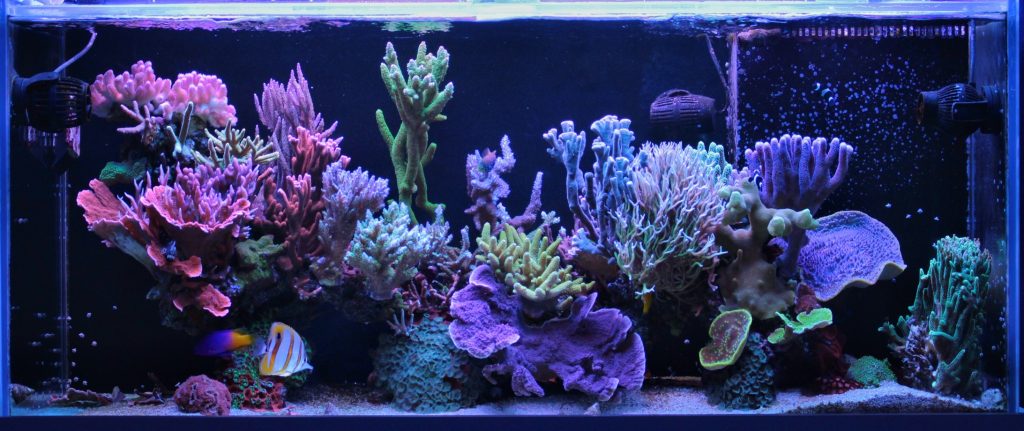
We discovered in the previous editorial that the fundamental role of each marine life support system is to facilitate efficient degas and regas, which occurs principally in the modern reef aquarium through vigorous water movement and air exposure in an uncovered display. The information in this series builds and consolidates upon previous insights and is thus essential background.
Phosphate is ergonomic and economic to control by fluidizing or forcing water through granular ferric oxide (GFO) and its subsequent recharge, so the principal stumbling block for SPS coral care remains the moderation of nitrate, because these corals turn brown and enter a chronic dormancy when exposed to the ambient concentrations found in other types of aquaria. Nevertheless, the growth but not the color of these colonies may be normalized by raising carbonate hardness to ~14.5 dKH (~5.18 meq l-1; ~259 mg l-1 CaCO3; Hylkema 2014).
Our only enriched nitrate-mitigating strategy is to exploit and optimize the potentially hazardous natural processes occurring in proximal suboxic and anoxic zones within substrate, rock, or sump bricks (Dornhoffer 2014). Perilous anoxia is unnecessary for denitrification, so herein we ascertain how to optimize microaerobia and minimize anaerobia.
Dedicated or SPS-dominated captive reefs require “in-tank” turnovers and sump throughputs of 70 and 10 times the entire system volume per hour.
Aquarists were previously limited to powerheads before the development of wavemakers that directed flow around the display in predictable and defined ways. “In-tank” setups were mostly Berlin where a “bare bottomed” aquarium accommodated around 0.6 kilograms of live rock to every UK gallon. Each rock was arranged to present optimal surface area by minimizing contact with its neighbor and all powerheads were nestled inconspicuously within the reef which was often wobbly.
Displays lacked substrate because pioneering undergravel filter-centered husbandry had highlighted potentially catastrophic detrital fouling in the 1970s, yet such prerogatives were blurred by the initially extremely useful “in-tank” deep sand beds (DSBs) and plenums of the 1990s.
Prior to the uniform plenum-like voids of later undergravel filters, they were originally constructed from networks of pipes with holes which optimized both nitri- and denitri-fication (Price, personal communication).
Berlin systems were filtered merely by their wall-like reefs and flow, so unlike the haphazard wavemaker positioning of today, rock quantities and circulation became critical considerations. Water was drawn passively from the hind reef then ricocheted off the viewing panel to surge the façade, where much was focused upwards. Fine particle filtration was used merely for GFO and the occasional bag of granular activated carbon (GAC).
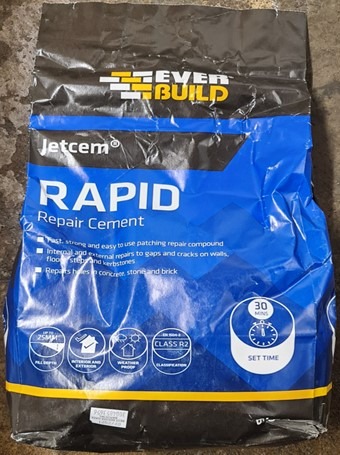
Fig 1. Jetcem® is a rapid curing Portland cement sold in the UK that does not require a brine cure, yet it is very hazardous thus exercise care, wear PPE and heed the prescribed precautions.
Most aquarists have conspicuous wavemakers directed towards their reef which have become minimalistic compared to the structures of the past. Several are formed from simply coral which confers a stunning natural look. However, hobbyists now opt for “in-tank” deep substrate or a sump system to process nitrogen, and oval-bodied fish lack flow refuge, and thus circulation is lessened at night when it is most needed.
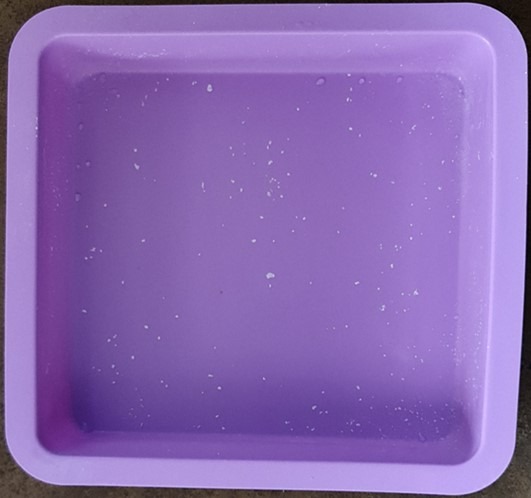
Fig 2. A silicone mould available on selling platforms from 4GBP.
Sustainable captive reef ecology relies upon detrital purging which is child’s play with a sump system because display effluent is filtered through a 100-micron (micrometer; µm) polyester needlefelt filter sock then protein skimmed to export any stray suspended solids and some dissolved organic compounds. Now eminently detritus-free, it can safely flow over a sump cabinet-monopolizing plenum or DSB where illumination cultures algae in a refugium. These sumps may be isolated, stripped, recommissioned, and seeded in an afternoon with prewashed substrate on hand when the efficacy of their DSB or plenum wanes due to inevitable detrital fouling. “In-tank” turnover and rock will sustain life support during sump overhaul at which juncture minimalistic reefs may be particularly unstable.
The above configuration favors nutrient limitation in combination with a fluidized reactor housing GFO where nitrate (NO3–) and phosphate (PO43-) attain less than 0.45 and 0.045 mg l-1 (ppm). Prolonged nutrient dearth is lethal to SPS colonies so realistic targets are 0.75 and 0.065 mg l-1 respectively.
Aquarists are alerted to nutrient limitation when their SPS corals become pastel which is a sign that the coral’s zooxanthellae are dying. To be clear, most zooxanthellae are golden brown (Yu et al. 2000) except after wounding and repair (Palmer et al. 2011). Notwithstanding, attaining nutrient limitation places the aquarist in complete control, insofar as most systems do not attain the ultra-pure conditions common to pristine wild reefs and buying another fish and increasing feeding is a luxury. Alternatively mud substrates like Miracle Mud® continuously liberate trace amounts of iron, nitrogen, and phosphorus which exacerbate the growth of unsightly algae without stringent nutrient management, albeit negligeable mud may enhance stability.
“In-tank” DSBs or plenums accumulate detritus and there are successful hobbyists that routinely use a gravel syphon and disturb anoxic porewater in profoundly toxic euxinic substrate. The experienced clean merely a 4-inch strip monthly. The author has witnessed healthy fish go instantaneously belly up during acute hydrogen sulphide (H2S) poisoning where the pH of life support is destabilized for ~10 to 14 days during which further mortalities occur. Systems have completely “crashed” where all livestock has perished.
So what is the answer? Avoid “in-tank” deep substrate and process nitrogen in safe and sustainable ways.
Sump bricks are efficacious DSB and plenum alternatives; however, like live rock, their entire exterior must be continuously exposed to high-velocity oxygen-laden water which buries H2S-rich euxinic zones beneath their surface. They will develop surface anaerobia if any part of them is positioned against glass or other sump bricks, which means, like DSBs or plenums, they cannot be disturbed safely. Even so, several allow water to pass through their center so removing them from water drains their internal anoxic regions and releases deadly toxins. They could be carefully manipulated and bagged submerged, however…
Aquarists comprehend that vigorous flow is required in their display, but water velocity abates the moment it enters a sump, so sump-located bricks and rocks often develop toxic iron sulphide (FeS)-rich grey/black zones on their surface which smell of rotten eggs when exposed to air (Jørgensen et al. 2018).
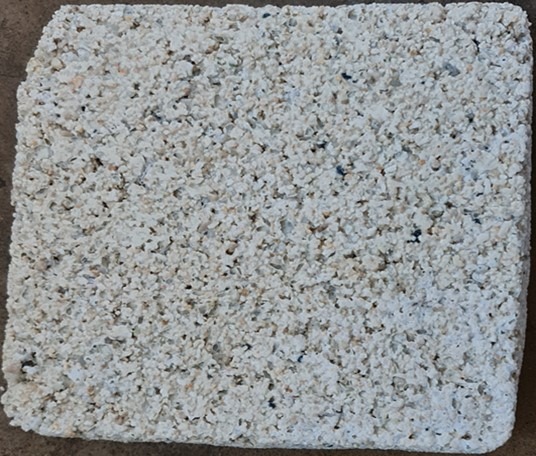
Fig 3. A DIY sump brick that consistently refused to denitrify because the ratio of cement to coral substrate was too high.
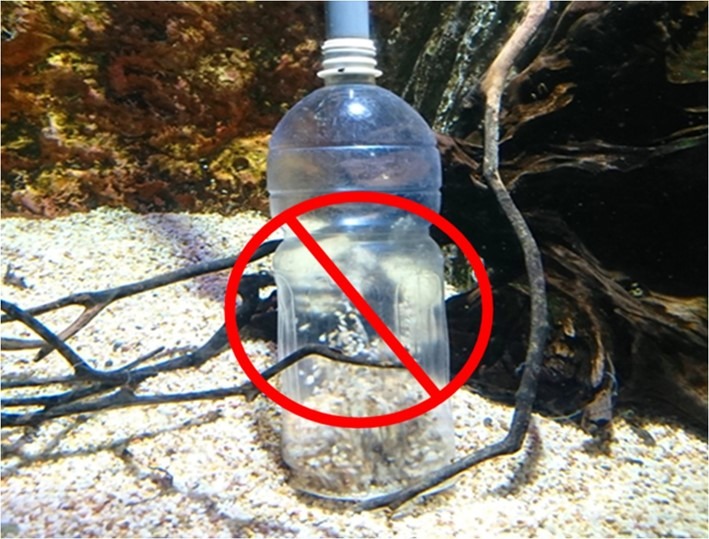
Water changes will lessen significant nitrate concentrations but they are ineffectual at alleviating minor, and large water changes are actively discouraged because they introduce instability. Synthetic saltwater is distinct from that of the system no matter how diligently it is prepared insofar as water clarity and luster are restored the day before a weekly water change.
A substratum called grotto rock was available in rock-sized pieces in the 2000s. It provided a real alternative to live rock because it became inhabited by crustose coralline algae and developed masses of nitrogen cycling microbes. Alas, it appears no longer available, yet rubble-sized pieces are marketed as the pond filtration medium alpha grog. A large and powerful nitrogen-cycling external cannister filter filled with alpha grog could be disconnected and rinsed in aged seawater every two months before recommissioning. Regardless alpha grog is better value than sump bricks, will offer a similar efficacy, and contains iron and other trace elements because it is the slag from glass manufacture.
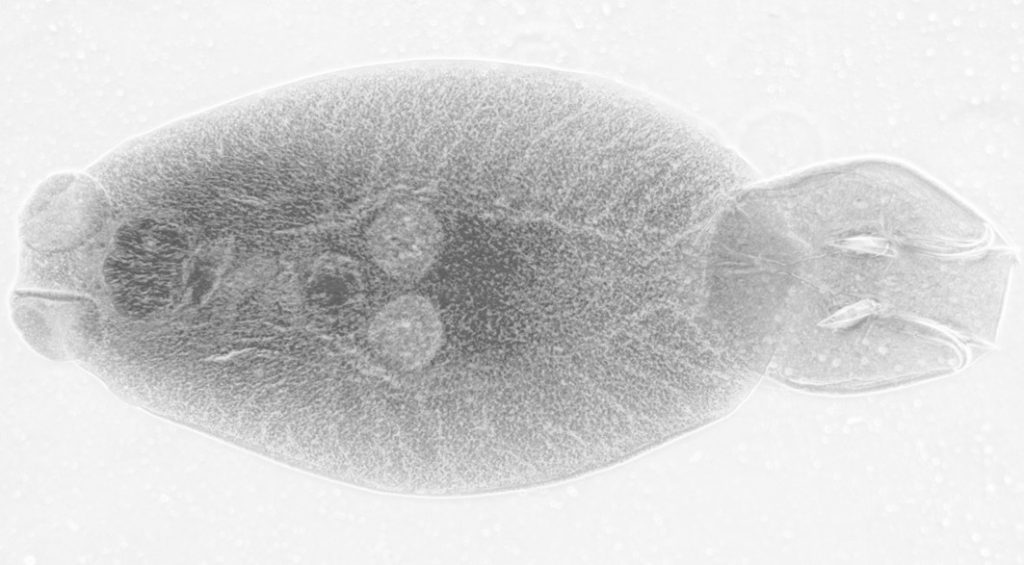
Fig 4. A micrograph of the monogenean fluke, Neobenedenia melleni that plagues ornamental marine teleosts. Note the posterior attachment organ called the haptor that bears hooks (hamuli; Ravi & Yahaya 2016).
Agarocrete reputedly processes nitrogen like live rock, albeit the author’s experiments suggest that most formulations have the nitrogen cycling competency of glass. Thoro® rapid vertical, Jetcem® rapid, and Bostik® cementone contain silicon dioxide (SiO2; quartz) and Portland cement (CAS No. 65997-15-1; EC No. 266-043-4) which are harmful when ingested or inhaled or when in contact with the skin or eyes because they can induce permanent blindness (Fig 1.; Everbuild 2015; Bostik 2018). Personal protective equipment (PPE) is mandatory such as a respirator, eye protection, gloves, clothing and use in a well-ventilated area devoid of wind because these cements are explosively flammable when suspended in air. They do not require a brine cure like traditional agarocrete and set in 30 minutes, and square silicone molds are widely available on selling platforms (Fig 2.). A tea- to table-spoon of cement can be blended with enough ~10 millimeter coral gravel and gently deposited in a mold and left an hour to cure. The ratio of cement to coral substrate is pivotal because when diminished the bricks have nil integrity, whereas elevated ratios occlude their microporosity which determines their cycling competency. Alternatively raise permeability by mixing with coarse granular solar salt or formulate with bicarbonate of soda and blend with citric acid immediately before casting. Other worthwhile trials might exploit quick or slaked lime as a cement alternative which is also very hazardous and will require a 14-day brine cure before use (Delbeek & Sprung 2005a; Xu et al. 2019). Quick lime is very caustic and reacts exothermically with water so take precautions and wear the aforementioned PPE, whereas slaked lime is kalkwasser pulverized aggregate.
Nevertheless, all cements but not lime contain toxic and carcinogenic hexavalent and trivalent chromium (Cr VI; Cr III). Reducing agents keep Cr VI within toxic constraints during cement shelf lives, but after they expire these species enrich in the bag and within solidified cement matrices (CSTEE 2002; Halim et al. 2004; La Farge Cement UK 2009; Estokova et al. 2018). Studies suggest their leaching will eliminate a vast cross-section of reef biota and destabilize ecology at parts per billion (µg l-1; Australian Government Initiative 2000). That said, agarocrete has been exploited in recirculating systems for decades without apparent harm despite Cr VI prevailing as CrO42- at optimal reef pH (Pettine 2000). Corals cultured in the tropics are mounted on agarocrete bases which frequently have a central underside dimple, so preclude sub-colony standing water.
When constructing traditional and aesthetic wall-like reefs, consider directing flow from rear to front and nestle your flow devices within the reef but they must be eminently accessible for maintenance, so position displays no closer to the surrounding walls than the width of an arm. Two overhead Maxspect Gyres could be staggered with two or three lower EcoTech VorTechs.
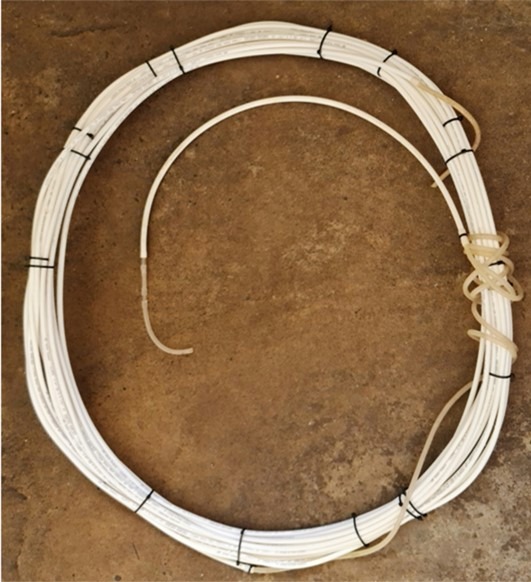
Fig 5. A coil denitrifyer constructed from 30 metres of John Guest® ¼” tubing, small sections of 5-millimetre outer diameter (OD) acrylic pipe, and short lengths of silicone airline. Aslett ©.
Carbon dosing evidently sustains oligotrophy in captive reefs dominated by azooxanthellate Scleractinia which is testament to its effectiveness because such corals require daily profusions of zooplankton (Delbeek & Sprung 2005). The author’s experiments also established a significant downturn in nitrate and phosphate to the point that reefs required supplementing with daily dropwise mains “tap” water additions to ameliorate nutrient limitation. However, all SPS colonies died which concurs with other studies (Kline et al. 2006; Feldman et al. 2011) which was not due to nutrient dearth. Furthermore vodka (ethanol) elicited widespread cyanobacterial blooms (Feldman et al. 2011) which are indicative of diminished DO and reductants and ethanol’s proficiency for nutrifying anaerobic zones and upregulating H2S have been noted (Letelier-Gordo et al. 2020).
Praziquantel is an efficacious wormer which assists elimination of Neobenedenia melleni AKA “the eye parasite” (Fig 4.). The drug requires dissolving in a small amount of high-purity ethanol to make it water soluble. The author has consistently observed reef water turn grey within 24 hours of praziquantel administration which is a typical response to sulphuric acid (H2SO4) or H2S and derivatives, but this does not occur in fish-only systems exploiting merely aerobic filtration. Furthermore, anoxic calcium reactors reliably elicit rapid tissue necrosis (RTN)-like symptoms in SPS colonies which is most likely a preprogrammed cell death (apoptotic) response to cytochrome c oxidase intoxication (Jahn & Theede 1997; Soto et al. 2012; Sharma et al. 2017).
Denitrifying filters are notoriously hazardous because several types function on a knife-edge of H2S production, yet putrefaction is unnecessary for denitrification.
Some suggested directing euxinic effluent through coral gravel was sufficient to neutralize the toxicity and acidity of H2S. The author responded by inventing feather duster lion taming as he considered it would have an analogous efficacy.
Coil denitrifyers are by far the safest, trouble-free, and cost-effective. They consist of 100 feet of opaque narrow-bore tubing supplied with a fast dribble of effluent cable tied in a wide arc (Fig 5.). Oxygen-respiring nitrifying microorganisms inhabit the initial coil until DO barely exceeds zero whereafter denitrifying microaerophiles predominate. The coil is fed with a mini powerhead with the top beautification panel removed or its effluent is extracted using a peristaltic mounted over water. There is no safety margin and thus their throughput must be checked twice daily because they will generate H2S if the tubing is too long or their flow is deficient. Install with a rapid dribble and leave for three months to fully mature.
Nitrate concentrations may still rise despite our best-efforts and thus we must develop nutrient management skills and be unwavering custodians of water quality. Overfeeding and rotting flesh are common causes of eutrophy for which part IV offers helpful guidance.
References
Australian Government Initiative (2000) Austria & New Zealand Guidelines for Fresh and Marine Water Quality. Chromium in freshwater and marine water. https://www.waterquality.gov.au/anz-guidelines/guideline-values/default/water-quality-toxicants/toxicants/chromium-2000#:~:text=Factors%20that%20affect%20toxicity%20of,review%20by%20Pawlisz%20et%20al.&text=In%20contrast%2C%20in%20hard%20water,it%20was%2067.4%20mg%2FL
Bostik (2018) Safety Data Sheet. Cementone Rapid Setting Cement. https://travisperkins.scene7.com/is/content/travisperkins/Cement-Cementone-Rapid-Set-Cement-5kg~E6912_351868_COSHH_0
CSTEE (2002) Scientific Committee On Toxicity, Ecotoxicity and The Environment (Cstee). Risks to Health From Chromium Vi in Cement. European Commission Directorate-General Health and Consumer Protection. https://ec.europa.eu/health/archive/ph_risk/committees/sct/documents/out158_en.pdf
Delbeek, J., C. & Sprung, J. (2005) The Reef Aquarium: Science, Art, and Technology. Two Little Fishes Inc., d.b.a. Ricordea Publishing, 1007 Park Centre Blvd., Miami Gardens, Florida 33169, USA. p 575.
Delbeek, J., C. & Sprung, J. (2005a) The Reef Aquarium: Science, Art, and Technology. Two Little Fishes Inc., d.b.a. Ricordea Publishing, 1007 Park Centre Blvd., Miami Gardens, Florida 33169, USA. pp 521-567.
Dornhoffer, T. (2014) Nitrogen Cycling Revisited: Sand, critters, carbon, and why you may be under-feeding your tank. AdvancedAquarist.com. https://www.advancedaquarist.com/2014/5/chemistry
Estokova, A., Palascakova, L. & Kanuchova, M. (2018) Study on Cr(VI) Leaching from Cement and Cement Composites. International journal of environmental research and public health. 15(4), 824.
Everbuild (2015) Jetcem Rapid Set Cement, Safety Data Sheet, according to regulation (EC) No. 1907/2006. https://www.everbuild.co.uk/wp-content/uploads/2017/08/Jetcem%20Rapid%20Set%20Cement%20SDS%20v2.3.pdf
Feldman, K., S., Place, A., A., Joshi, S. & White, G. (2011) Water: Baseline Values and Modulation by Carbon Dosing, Protein Skimming, and Granular Activated Carbon Filtration. AdvancedAquarist.com. https://www.advancedaquarist.com/2011/3/aafeature
Halim, C., E., Amal, R., Beydoun, D., Scott, J., A. & Low, G. (2004) Implications of the structure of cementitious wastes containing Pb(II), Cd(II), As(V), and Cr(VI) on the leaching of metals. Cement and Concrete Research. 34(7), 1093-1102.
Hylkema, A. (2014) Decreased growth of Stylophora pistillata with nutrient-driven elevated zooxanthellae density is largely explained by DIC limitation. Reefs.com. https://reefs.com/magazine/decreased-growth-of-stylophora-pistillata-with-nutrient-driven-elevated-zooxanthellae-density-is-largely-explained-by-dic-limitation/
Jahn, A. & Theede, H. (1997) Different degrees of tolerance to hydrogen sulphide in populations of Macoma balthica (Bivalvia, Tellinidae). Marine Ecology Progress Series. 154, 185-196.
Jørgensen, B. & Gallardo, V. (1999). Thioploca spp.: filamentous sulfur bacteria with nitrate vacuoles. FEMS Microbiology Ecology. 28(4), 301-313.
Kline, D., I., Kuntz, N., M., Breitbart, M., Knowlton, N. & Rohwer, F. (2006) Role of elevated organic carbon levels and microbial activity in coral mortality. Marine Ecology Progress Series. 314, 119-125.
La Farge Cement UK (2009) Health and Safety Information Portland cement (BS EN 197-1:CEM I) DAT SHEET. https://simongibsontransport.co.uk/wp-content/uploads/17-Portland-Cement-SDS.pdf
Letelier-Gordo, C., O., Huang, X., Aalto, S., L. & Pedersen, P., B. (2020) Activated sludge denitrification in marine recirculating aquaculture system effluent using external and internal carbon sources. Aquacultural Engineering. 90,.
Palmer, C., V., Traylor-Knowles, N., G., Willis, B., L. & Bythell, J., C. (2011) Corals use similar immune cells and wound-healing processes as those of higher organisms. PLoS ONE. 6, e23992.
Pettine, M. (2000) Redox Processes of Chromium in Sea Water. Gianguzza, A., Pelizetti, E. & Sammartano, S. (eds.). Chemical Processes in Marine Environments. Environmental Science. Springer, Berlin, Heidelberg. Chapter 15.
Price, D., J. (2002) Aquarium Science Module. The University of Plymouth, UK.
Ravi, R. & Yahaya, Z. (2016) Neobenedenia melleni Parasite of Red Snapper, Lutjanus erythropterus, with Regression Statistical Analysis between Fish Length, Temperature, and Parasitic Intensity in Infected Fish, Cultured at Jerejak Island, Penang, Malaysia. Journal of Parasitology Research. 2016,.
Sharma, V., Jambrina, P., G., Kaukonen, M., Rosta, E. & Rich, P., R. (2017) Insights into functions of the H channel of cytochrome c oxidase from atomistic molecular dynamics simulations. Proceedings of the National Academy of Sciences. 114, 10339-10348.
Soto, I., C., Fontanesi, F., Liu, J. & Barrientos, A. (2012) Biogenesis and assembly of eukaryotic cytochrome c oxidase catalytic core. Biochimica et biophysica acta. 1817(6), 883-897.
Xu, Q., Ji, T., Yang, Z. & Ye, Y. (2019) Preliminary investigation of artificial reef concrete with sulphoaluminate cement, marine sand and sea water. Construction and Building Materials. 211, 837-846.
Yu, J., Liao, T., Chen, C., Liao, T., Fang, L. & Tsai, W. (2000) Do color patterns of Pocillopora damicornis reflect Zooxanthellae diversity? Coral Reefs. 19(1), 98-
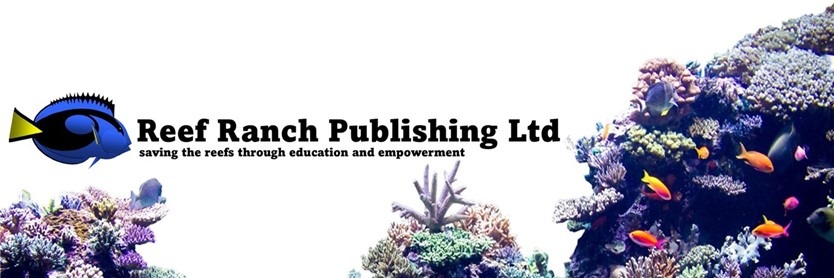



0 Comments